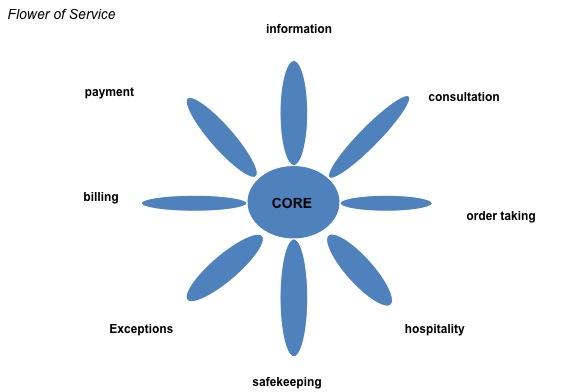The Flower of Service is a useful concept in marketing. It can be used to see the interaction between core products and supplementary services. Read this Flower of Service example essay below to learn more.
Introduction
The concept of Flower of Service is critical in displaying different supplementary services surrounding the core product. These supplementary services exist in the form of facilitating services and enhancing services. The components of the facilitating services in the Flower of Service chart include information, billing, payment, and order-taking. The components of enhancing services include consultation, safekeeping, exceptions, and hospitality.
Within the Flower of Service, the facilitating supplementary services are instrumental in service delivery in the form of creating the link for value addition in the core product. Thus, this reflective treatise attempts to explicitly explain the concept of Flower of Service and identify each of the petals. Besides, the treatise provides an insight into the concept to service marketer. In addition, the paper summarizes personal opinion on the relevance of extended breakout of facilitating and enhancing services to all service offerings today.
The Flower of Service Model
Borrowed from the nomenclature of a typical flower, the Flower of Service concept summarized the interaction between supplementary services existing in the form of facilitating services and enhancing services within the core product. The concept presents the facilitating services and enhancing services within the scope of their interaction to complete service marketing goals (Lovelock & Wirtz 2011). The supplementary services within the Flower of Service are discussed below.
Facilitating services
The components of facilitating services include information, billing, payment, and order-taking. Under information, the elements such as physical directions, schedules, prices, instructions, warnings, reminders, confirmations, and conditions of services are listed. These elements interact to ensure that the quality of services meets the information provided to guarantee successful marketing.
The elements of order-taking include applications (subscription services and prerequisite activities), order entry components (website, telephone, and order fulfillment), and reservations (seats, equipment rental, admission facilities, and professional appointment). The billing elements include periodic account activity statements, invoices, machinery displays, and self-billing. Among the elements within the payment function include self-service (EFT, token, cash, and number in the credit card), intermediary (change giving, handling of debit cards, coupon redemption, and check handling), and automatic deductions such as human systems and other automated systems (Lovelock & Wirtz 2011).
Enhancing services
The components of enhancing services include consultation, safekeeping, exceptions, and hospitality. The elements of consultation include technical consulting, customized services, and training to ensure that the concept of service marketing is all round and appropriate for each type of service. On the other hand, hospitality elements include security, greetings, amenities, eateries, and transport.
The elements of safekeeping include taking care of customers’ possessions (child, pet, coats, baggage, and personal security) and taking care of rented or purchased goods by customers (pickup, delivery, installation, refueling, upgrade, cleaning, repairs, and packaging). Lastly, the exception elements within the Flower of Service include handling advance special requests (dietary, disability, religious requirements, and needs of children), handling exceptional communication (suggestions, complaints, compliments, and opinions), problem-solving, and restitution (refunds, free services, monetary or other forms of compensation, and discounts) (Lovelock & Wirtz 2011). The concept of the Flower of Service is summarized in the figure below.

Insights about the Flower of Service Concept
As a condition for the successful establishment of a service business, it is imperative for service marketers to initiate a well-researched plan for penetration and substance in order to transform the business into an actually profitable venture, especially in the sensitive service industry. The main elements that should be reviewed by a service marketer include market penetration strategies, objectives and goals, likely competition, and the general business environment (Kowalkowski, Kindstrom, & Brehmer 2011).
Therefore, the concept of Flower of Service is critical to service marketers since it endeavors to ensure trust and quality service to clients irrespective of the time of visit, observance of maximum business standards which must meet the set government standards for operating a service business, healthy relationship with customer through constant and continuous response irrespective of the nature of magnitude of the complaint or compliment (Anderson & Narus 1995).
Through the adoption of the Flower of Service concept, service marketers will be able to establish a two-way communication framework and customer care initiative to address the concerns of the customers. The customer care initiative can double up as the public relations strategy in order to win and keep customers. As a result, the customers of a service establishment will develop a tight relationship with the business since they will perceive it as a caring establishment (Wu & Whinston 2008).
Personal reflection
The relevance of extended breakout of facilitating and enhancing services to all service offerings today is as stable as it was a decade ago. In fact, service marketers may use the Flower of Service concept to develop attractive marketing mission statements based on the quality of the services. As a plan for realizing such a mission, a service marketer may be in a position to create eye-catching positioning statements capturing the elements of quality, affordability, and reliability for a service business. Since most service businesses have similar customers, balancing supplementary services in the form of facilitating services and enhancing services may make a difference in sustainability, efficiency, and satisfaction as perceived by customers.
Reference List
Anderson, J, & Narus, J 1995, “Capturing the values of supplementary services.” Harvard Business Review, vol.3, no. 1, pp. 75-83.
Kowalkowski, C, Kindstrom, M, & Brehmer, P 2011,”Managing industrial service offerings in global business markets.” Journal of Business & Industrial Marketing, vol. 26, no. 3, pp. 181-192.
Lovelock, C.H, & Wirtz, J, 2011, Services Marketing: People, technology, strategy, McGraw Hill, New York.
Wu, D, Ray, G, & Whinston, A 2008, “Manufacturers’ Distribution Strategy in the Presence of the Electronic Channel,” Journal of Management Information Systems, vol. 25, no. 1, pp. 167–198.